Georgetown –
Batu Ferringi [Malaysia]
Brits abroad
The old British colonial days always tend to leave a bit of a bitter taste in the mouth don't they. This daft paternal notion we had of roaming around civilising the world stinks like a rather convenient way of glossing over the pillaging we took part in. But every now and then we stumble into something that actually seems to have turned out alright after we stuck our noses in.
 Georgetown, like Singapore, was a quiet little island when Sir Francis Light alighted there in 1786. A few fishing villages here and there, a whole lot of jungle, and not much else. Well, it was ours now, apparently. The British laid claim to the island – the first of the East India Company's possessions in South-East Asia – thanks to a marvellously cynical piece of backhanded diplomacy whereby we promised to help the Sultanate of Penang fight against his enemies in Siam if he gave us this little island, and then stubbornly failed to lift a finger when the time came to make good our promise. This is presumably the same honourable behaviour that we expected the natives to pick up from us civilised British while we went about nicking their stuff.
Georgetown, like Singapore, was a quiet little island when Sir Francis Light alighted there in 1786. A few fishing villages here and there, a whole lot of jungle, and not much else. Well, it was ours now, apparently. The British laid claim to the island – the first of the East India Company's possessions in South-East Asia – thanks to a marvellously cynical piece of backhanded diplomacy whereby we promised to help the Sultanate of Penang fight against his enemies in Siam if he gave us this little island, and then stubbornly failed to lift a finger when the time came to make good our promise. This is presumably the same honourable behaviour that we expected the natives to pick up from us civilised British while we went about nicking their stuff.
 Georgetown, like Singapore, was a quiet little island when Sir Francis Light alighted there in 1786. A few fishing villages here and there, a whole lot of jungle, and not much else. Well, it was ours now, apparently. The British laid claim to the island – the first of the East India Company's possessions in South-East Asia – thanks to a marvellously cynical piece of backhanded diplomacy whereby we promised to help the Sultanate of Penang fight against his enemies in Siam if he gave us this little island, and then stubbornly failed to lift a finger when the time came to make good our promise. This is presumably the same honourable behaviour that we expected the natives to pick up from us civilised British while we went about nicking their stuff.
Georgetown, like Singapore, was a quiet little island when Sir Francis Light alighted there in 1786. A few fishing villages here and there, a whole lot of jungle, and not much else. Well, it was ours now, apparently. The British laid claim to the island – the first of the East India Company's possessions in South-East Asia – thanks to a marvellously cynical piece of backhanded diplomacy whereby we promised to help the Sultanate of Penang fight against his enemies in Siam if he gave us this little island, and then stubbornly failed to lift a finger when the time came to make good our promise. This is presumably the same honourable behaviour that we expected the natives to pick up from us civilised British while we went about nicking their stuff. Today though, Georgetown stands tall and proud, squeezed against the north-eastern shore of the island at the foot of the steep hills that bubble up out of the island's interior. There are tall, multistorey stacks of concrete jutting up out of the city, but as we came off the ferry and rode down the roads, these new editions to the skyline disappear from view and we found ourselves pedalling by grand marble arches, chalk-coloured clock towers, and shuttered second storey windows, as though we were cycling around a period drama set, peppered with the bombastic pyramids of Hindu temples, dark arabic domes of mosques, and the lively racket found around street food stands.
Today though, Georgetown stands tall and proud, squeezed against the north-eastern shore of the island at the foot of the steep hills that bubble up out of the island's interior. There are tall, multistorey stacks of concrete jutting up out of the city, but as we came off the ferry and rode down the roads, these new editions to the skyline disappear from view and we found ourselves pedalling by grand marble arches, chalk-coloured clock towers, and shuttered second storey windows, as though we were cycling around a period drama set, peppered with the bombastic pyramids of Hindu temples, dark arabic domes of mosques, and the lively racket found around street food stands.
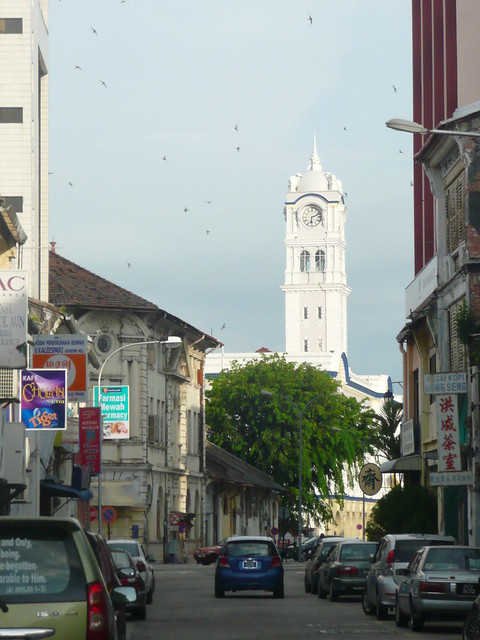 Georgetown is elegant, but with streaks of the lively colours of India, Malaysia, and China. She draws a sizeable number of tourists too, certainly the busiest place we'd been to in Malaysia at any rate; catching those folk dipping in from Thailand, people on the island hop tour from Thailand to Indonesia, foodies seeking out the island famous for its culinary capers, history buffs wanting a gander around the old lanes, and everyone else taking the tip from their guidebooks that this is a place worth visiting. And it is, it's great.
Georgetown is elegant, but with streaks of the lively colours of India, Malaysia, and China. She draws a sizeable number of tourists too, certainly the busiest place we'd been to in Malaysia at any rate; catching those folk dipping in from Thailand, people on the island hop tour from Thailand to Indonesia, foodies seeking out the island famous for its culinary capers, history buffs wanting a gander around the old lanes, and everyone else taking the tip from their guidebooks that this is a place worth visiting. And it is, it's great.
We had a bit of a bad time with the first hostel we moved in to though, who decided after we had checked in and paid for several nights that they didn't want our bicycles inside the building, and if we wanted to stay we had to leave the bikes outside in the street. This was the first time anyone has made us do this, and will probably remain the only one to tell us 12 hours after checking in, so we had to move out, get a refund, and find another place that would let us store our bikes securely. Thankfully this didn't take long as Georgetown is full of decent, cheap accommodation, and we found a place just two minutes up the road.
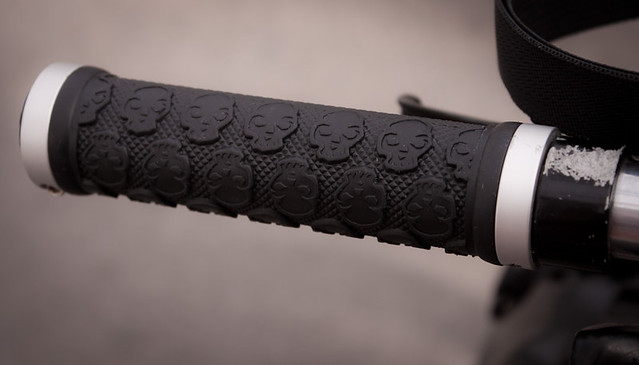 |
| Grrr! New grips -the old ones melted in the heat. |
We spent hours working on this goddam blog, it was draining as hell. Bleah. But we managed to get ourselves out and about around the town and tracked down a few decent eateries with top draw biriyanis and naan's. We spent an afternoon exploring Francis Light's old fort, which despite being studded with impressive looking cannons, had a wall only ten feet high that any invading force could have easily clambered over. Fort in name, but in reality it served only as an administrative centre for the eastern arm of the East India Company.

 |
| Snake Temple, Penang |
Those of you easily bored by talk of colonial era architecture, history and bicycle maintenance will be as happy as we were when we discovered there's a mother-flipping snake temple on the island too. No, they're not worshipping snakes there, it's a shrine to Chor Soo Kong, the Chinese equivalent to a saint, who among his many good and worthy deeds gave some snakes shelter from some peril or other. When this temple was built on Penang island to worship him, do you know what miraculously started coming to the temple to take shelter? That's right, snakes. What are the odds of that?
Nowadays the
miracle of wild snakes coming slithering in unbidden doesn't happen
quite so often, so the temple has it's own snake farm and breeding
centre so that pit vipers can be draped over every plant and shrine
inside. As anybody with a passing interest in snakes will know, pit
vipers are highly venomous, and so one has to hope as you wander past
a tangle of them dangling at head height from a pot plant, that the
stories about them all being de-venomed are true, and the signs
dotted around saying that you should keep a safe distance or “Their
kiss may be your last” are just part of the show.
 The temple was
almost an hour's cycle from our guest house, so we decided to take a
little diversion through the hills on the way back to visit the Kek
Lok Si temple, a spectacular complex of Buddhist devotion straddling
one of the hillsides, and laying claim to being the largest Buddhist
temple in South-East Asia.
The temple was
almost an hour's cycle from our guest house, so we decided to take a
little diversion through the hills on the way back to visit the Kek
Lok Si temple, a spectacular complex of Buddhist devotion straddling
one of the hillsides, and laying claim to being the largest Buddhist
temple in South-East Asia.After locking the bikes up and traversing a seemingly endless tunnel of commerce – selling everything from 3-D Hindu deity posters to imitation dog poo – we came across a pond squirming with hundreds of terrapins and a bloke flogging handfuls of lettuce with which to feed them. Further on up through these levels of worldly pleasures we past more shops until finally coming out into a bright square with a cream coloured stone path leading off in two directions; left to a courtyard populated by hundreds of buddha statues surrounding a shrine to the blissful one, and right to a spectacular cake of a building, the Ten Thousand Buddhas tower, coconut coloured with gold trimming, it looked like a meringue fit for Siddartha.
Around and
between these two focal points were great looming caves inhabited by
golden gods smouldering with incense. Elsewhere the lofty stone walls
of a temple had been chiselled into an intricate series of images
depicting Buddhist stories. Although this complex is relatively new
to the temple scene, being constructed around 1900, it carries itself
with a level opulence and beauty as staggering as that of Borobudor.
It's jaw dropping, whatever your religious persuasion.
 We took an
escalator up the final hill to a colossal statue of the goddess of
mercy, laying out her good will down across the view back to
Georgetown below us. Happy, tired, and presumably at least a little
bit blessed (unharmed by pit vipers at any rate) we cycled back into
town as the embers of dusk settled on the horizon, and we made plans
to move on.
We took an
escalator up the final hill to a colossal statue of the goddess of
mercy, laying out her good will down across the view back to
Georgetown below us. Happy, tired, and presumably at least a little
bit blessed (unharmed by pit vipers at any rate) we cycled back into
town as the embers of dusk settled on the horizon, and we made plans
to move on.
Lazy boys.
Penang
island has it all really. Not only does it boast cosy colonial era
streets, great big temples and excellent food, but it also has a
smattering of excellent beaches, and it was to one of these that we
headed after our few days in the city. Penang isn't a big place, we
could probably ride around it in a day, so it only took us an hour to
get to the beaches of Batu Ferringhi that lay about 15km away to the
north.
We struck it
lucky with our choice of accommodation, nailing a cheap, laid back
place across the road from the beach, aptly called Lazyboys. A low
gate led into a communal area complete with chairs, speakers for
ipods, guitars, a kitchen area, and lots and lots of cats.
Aslan, the
proprietor was a venerable master in the art of kicking back. We
would find him asleep in one of the many hammocks that hung about the
place, or fussing over one of his feline companions, or cranking up
Guns n' Roses in the music room and howling along. Lazyboys had
nailed the feel that backpacker's love, genuinely relaxed and homely,
the kind of place you remember for decades to come. It's hard to
quantify these things, you just know when you come across them, but I
reckon having an arsenal of kittens roaming about, coupled with
regular supplies of mini-mangos dropping and rolling down the roof
for collection certainly helped.
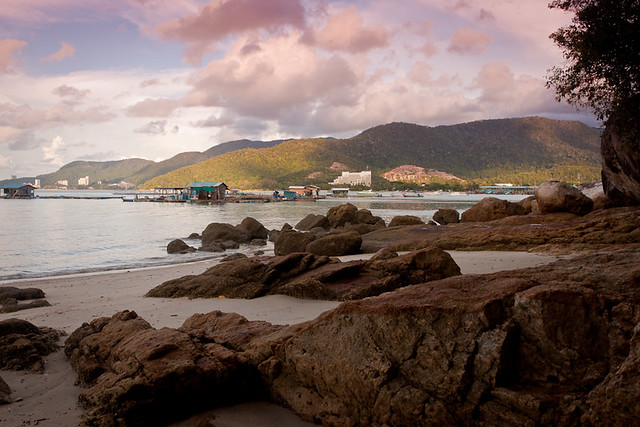 We thoroughly enjoyed our few days here, hanging out in the communal area, sharing meals (which we could cook ourselves in the kitchen), and strolling along the beach. Although the coast was well developed, the beach itself was not overwhelmed by concrete and commercialisation.
We thoroughly enjoyed our few days here, hanging out in the communal area, sharing meals (which we could cook ourselves in the kitchen), and strolling along the beach. Although the coast was well developed, the beach itself was not overwhelmed by concrete and commercialisation.
Bamboo bars spilt onto the sand, we were offered plenty of massages and paragliding opportunities, but not to any excessive degree. It was low season, and those hawkers still hanging around on the sand seemed resigned to bad business.
We slowly ambled, arm in arm, occasionally dashing to avoid an incoming paraglider, and yet joined at every step by the gentle sweep of the waves, which were unfortunately blended up with the endless drone of jet skis skimming past. Nice though it was, when we heard of a quieter beach further west we decided we'd give that a shot, so one morning we caught the bus down the way to visit the aptly named Monkey Beach.
 We thoroughly enjoyed our few days here, hanging out in the communal area, sharing meals (which we could cook ourselves in the kitchen), and strolling along the beach. Although the coast was well developed, the beach itself was not overwhelmed by concrete and commercialisation.
We thoroughly enjoyed our few days here, hanging out in the communal area, sharing meals (which we could cook ourselves in the kitchen), and strolling along the beach. Although the coast was well developed, the beach itself was not overwhelmed by concrete and commercialisation. Bamboo bars spilt onto the sand, we were offered plenty of massages and paragliding opportunities, but not to any excessive degree. It was low season, and those hawkers still hanging around on the sand seemed resigned to bad business.
We slowly ambled, arm in arm, occasionally dashing to avoid an incoming paraglider, and yet joined at every step by the gentle sweep of the waves, which were unfortunately blended up with the endless drone of jet skis skimming past. Nice though it was, when we heard of a quieter beach further west we decided we'd give that a shot, so one morning we caught the bus down the way to visit the aptly named Monkey Beach.
The beach in
question wasn't exactly off the beaten track, but the beaten track
that led there was certainly hard work, trailing up and down through
dense jungle, with plenty of clambering and sliding down muddy banks.
Once we got there we were rewarded with the sound of jetskis, and
macaques bearing their fangs at us so they might pilfer our peanuts.
We packed up our beach towel and headed further up the beach away
from these nasty little simians, and enjoyed something like a
relaxing afternoon; swimming, reading, and keeping an eye out for
villainous monkeys.




3848 -4676km
Batu Ferringi
[Malaysia]- Trang – Krabi – Tonsai – Nakhon Si Thammarat
[Thailand]
Rising hills,
falling rain, and phonetic languages.
All things come
to pass, said Buddha as he scoffed the last piece of the pavlova, and
so too must our 3 month Malaysian tourist visa. We only had a few
days left to get out of the country, and still had a few hundred
kilometres to go to the border. We left the horizontal life of
Lazyboys amid a fierce rain shower, crossed the water on the ferry,
and met up again with Rickee-Lee and his wife for a celebratory meal.
It had been Rickee-Lee's birthday the day before, and our time in
Malaysia was drawing to a close. Excellent excuse for a big lunch!
Our midday feast
of fish and drink with our friends stalled our motivation to get
going that day, so we returned to the hotel we'd stayed at 10 days
ago, and then left early the next day, out of the industrial
landscape of Butterworth and north alongside expansive green rice
fields dotted here and there with tractors chugging their way through
the flooded soil.
The north-western tip of Malaysia was very scenic and enjoyable, on the whole. We stopped off at the Lembah Bujang archaeological site, perched partway up a little hill, to see the remains of a 1st century temple that marked the focal point for early traders on the sea silk road.
The north-western tip of Malaysia was very scenic and enjoyable, on the whole. We stopped off at the Lembah Bujang archaeological site, perched partway up a little hill, to see the remains of a 1st century temple that marked the focal point for early traders on the sea silk road.
The site was okay, but they had gone a bit overboard with
reconstructing parts so you didn't know what was old and what was new
which undermined the whole experience. But any disappointment with
old temples was made up for by an immense thunderstorm that moved in
the next morning to wake us up by exploding above us, quite literally
shaking the entire hut and blowing the electric. Very glad we weren't
camping that night! When it finally moved on, leaving a stunned,
dripping jungle behind, we loaded our bikes and headed out for our
final day in Malaysia.
What had been
long expanses of flat cultivation swelled into rolling hills, and
then down again into a fast ride along a freeway. We took a very
cheap hotel/homestay affair in a rather bleak industrial estate on
the Malaysian side of the crossing, but unfortunately that night, as
we rechecked our map, we discovered that we were on the wrong side of
a range of steep hills. This meant that not only did the road lead
away from the west coast where we were aiming for, but it also lead
into the troubled regions in the south of Thailand, plagued by
bombings and shootings as part of an ongoing terrorist campaign
there.
Nothing for it
really.
The next day, and
the last day on our Malaysian visa, we backtracked a little way and
then cut through a series of country lanes that snaked west until we
made it to the most westerly border crossing, nestled at the top of a
series of unforgiving winding uphill roads. The sun that had cooked
us on the way up was smothered beneath a plume of sky-eating monsoon
cloud and as we got our passports stamped, and pushed our bikes
through the crowds of market vendors and travellers the rain came
thick and heavy to welcome us to Thailand.
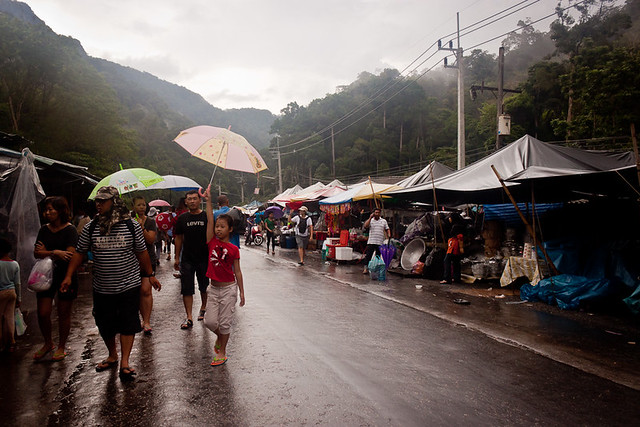 |
| Malaysia-Thailand border |
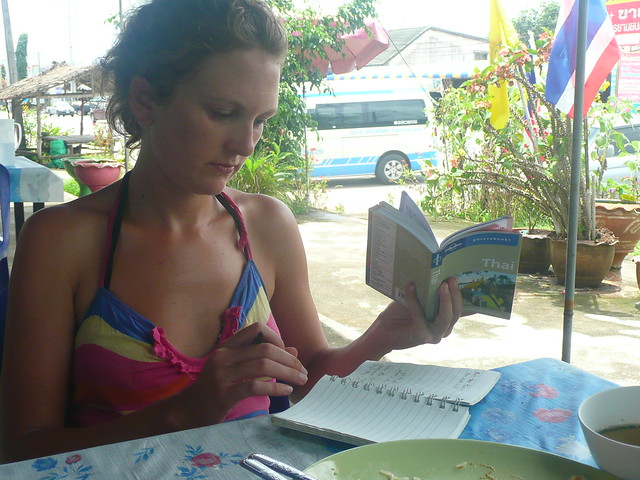 |
| Working on our Thai |
Learning foreign
languages had always been a bit daunting for me, and yet our
experiences in Indonesia and Malaysia went a very long way to showing
me how easy it is to get enough under your belt to get by without too
much trouble at all. So, the prospect of learning Thai was one we
were both looking forward to - we had a phrasebook and everything -
although we were sure we'd make a grand fool of ourselves trying to
get the pronunciation right in this tonal language.
What we hadn't
put much thought into though was the fact that Thai has it's own
alphabet, which is utterly indecipherable to two cyclists fresh in
the country. Even with the dictionary at the back of our phrasebook,
we found it impossible to find the first character of words we came
across, either because the font was slightly different, the word
wasn't in the dictionary, or we weren't picking up the nuances in the
flicks, circles and dots. All of a sudden we couldn't ride around
town looking out for hotel signs, because all signs were a confusing
mess of backwards c's, wiggles and symbols. All we could do is look
for buildings that looked like they might be hotels, then take a
closer look. Carpet shop. Someone’s house. Restaurant. Dam.
 |
| Despite looking like hell spawn in the signs, the cows are well behaved in Thailand. The dogs are bad though, very bad. |
We hurriedly
taught ourselves how to ask the whereabouts of a hotel, and then set
about confusing Thais by mispronouncing their vowels, and bobbing our
heads up and down as we strained to add rising, falling, high and low
tones to our discourse. Amazingly some people understood us, and we
were finally guided to a motel by a lovely woman on a scooter.
The good, the
bad, and the dogs.
While there is a
steep learning curve with the lingo in Thailand, thankfully there are
no such steep inclines as far as the roads go, not down in the south
anyway. We planned to take a(nother) mini holiday along the western
coast of Thailand in a place called Tonsai, famous for its rock
climbing. So from the border we headed straight for the sea so we
could enjoy the cool breeze that it afforded. From there, we would
follow the coast up to Krabi town, then catch a boat to the secluded
twin beach of Tonsai and Railay for a week clambering up limestone
and reading books on the beach.
We've found that
every country has its own set of challenges for the budding bicycle
tourist, but also conversely there's always something that gets a
little bit easier too once you hop across a border. In Thailand the
language is tough, but the accommodation is half the price of
Malaysia so keeping to a budget is much easier. In Thailand the roads
all seem very flat, but to keep us on our toes there are an abundance
of lively dogs. We may have bred out most of their wolfish
tendencies, but I tell you, if pretty much any dog sees a pink ape
trundling past on a bicycle they come dashing right after you, baring
their teeth and snapping at your heels like hyenas after wildebeest.
So the ride to Krabi was very nice, very flat - very easy really -
just punctuated with the occasional heart stopping moment of bared
teeth and barking courtesy of the local canine pack.
Thankfully though
so far, touch wood, we've found that the old trick of stopping,
getting off the bikes and walking is enough to put an end the chase.
They're not vicious, we don't think, they just think we're fair game
for a chase. Easier said than done though sometimes, when you have a
large angry dog barking and snapping alongside you, stopping and
getting off is the last thing you fancy doing, but it's worked so
far, and just in case it doesn't we've armed our handlebar bag
pockets with an assortment of large stones.
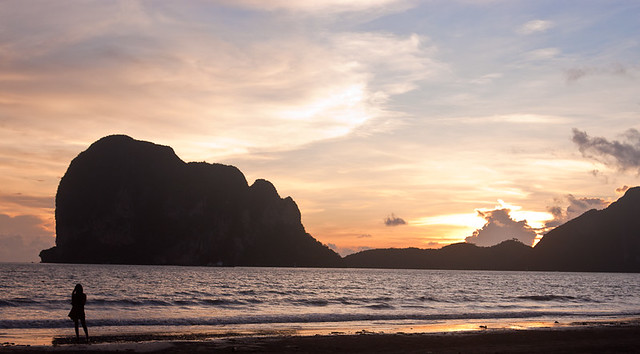 |
| The Trang coast. |
We covered a good
old distance on our way towards Krabi, knocking off close to or just
over 100km almost every day since Georgetown. Even along flats
though, keeping up this pace tends to wear us down after 5 days, so
although Krabi was only a touch over 100km away on the fifth day in
the saddle we found ourselves a little room on the Trang coast, by a
stretch of sand popular with local holiday makers.
Although this
coastal junction was pretty well rammed when we arrived, with
hundreds of locals moving about amid the muffled yelling of some rock
band playing down the way, and although the beach was strewn with the
empty bottles and wrappers and cigarette butts that come with being
the focus of mass tourism, the landscape still managed to remain
impressive and beautiful, with fat chunks of rock sat on the peach
horizon, so sheer as to be inaccessible to tour groups, and therefore
immune, for now, from the bustle and waste of the beach. These
limestone lumps made nice viewing as we strolled along the sea, and
when we woke the next day we found that the crowds had disappeared,
dissolved away leaving a strip of bamboo bars and beach side
restaurants all for us.
It's nice to see
the area so popular though, because like much of the west coast this
place was hit by the 2006 Tsunami. Behind the new bars and
restaurants we saw the remnants of concrete buildings broken open and
spilling metal supports, and the tsunami evacuation signs are
prominent, and everywhere. It's not something that's talked about too
much, for obvious reasons, because it cut deep into the people along
here. A week before, in Penang, we spoke to somebody who had
witnessed it, but his account quickly petered out and he took his
leave, visibly upset. The recent earthquake in Sumatra, that
triggered a tsunami warning across the region, although thankfully a
false alarm, must have sent chills up and down the coast, especially
along an area like Trang that really doesn't seem to have any higher
ground to flee to.
Tonsai
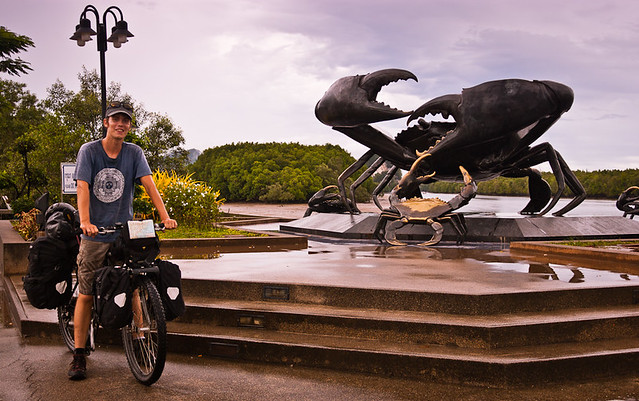 |
| Krabi. Geddit? |
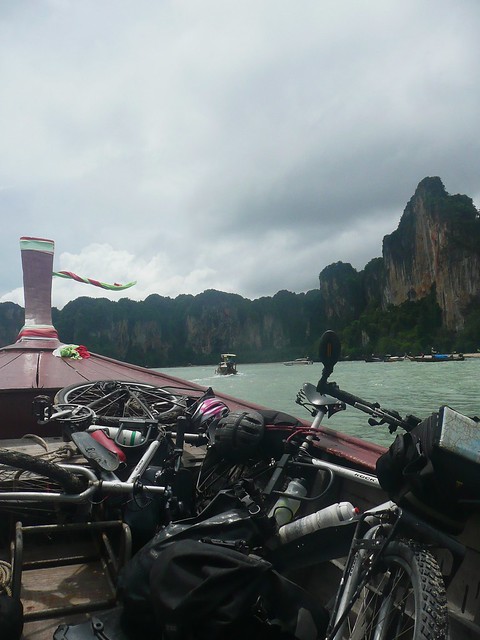 |
| On a mother-flippin' boat! |
We had some fun
with the boatman, despite being assured by the guy who sold us the
ticket that we would be taken to Tonsai, the boat dropped us off at
Railay beach instead, and when I broached the question of taking us
to where we'd been told we'd be taken to, I was confronted by foul
language and threats from the guy. Such are the pleasures of
travelling on the very well trodden path, where some people will tell
you anything if it gets them a few hundred baht.
Railay and
Tonsai, although a part of the mainland, are cut off from the outside
world by sheer cliffs of rock, so it's access by boat or no access at
all. We hopped off the boat into the shallow water and hauled our
bikes and the long line of black panniers out over our shoulders and
onto the concrete waterfront. This, our first sight of the place was
surprisingly neat, gleaming with expensive looking restaurants.
Railay is world famous among rock climbers as one of the best
climbing sites in the world – excellent routes to climb, very
cheap, and with stunning views of turquoise waters and palms, so we
were quite taken aback at how upmarket the place felt. Blanched
pillared restaurants overlooking the neat blonde beach, brand new
balconied apartments tucked away in the jungle, a stunted high street
sporting top brand rock climbing and diving equipment. The
accommodation prices here were set appropriately high, cheap perhaps
by international standards, but well out of our budget.
There is a walking track that connects the two beaches, but we decided to just bite the bullet and pay for another longtail boat around to Tonsai. A real pain in the ass, forking out extra money and having to unload the bikes again, and haul everything back into another boat, but it turned out to be the right move. We walked the track a few days later and it would have killed us on the bikes, and we would have been drained by the clouds of mozzies in no time. No, we got a boat, and this buy was very nice actually, and helped us out with our gear as we carried it all and reassembled it on the sand.
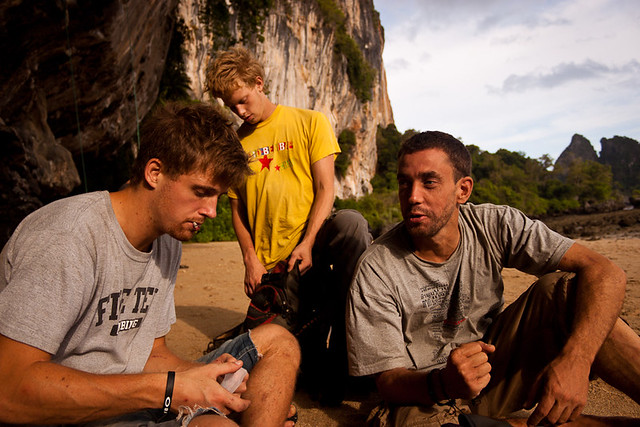 |
| Martin, Vlad and James |
All of which
might make Tonsai sound quite unpleasant, which would not be true at
all. Although it was very much in the low season there were still
lots of lovely people, mostly climbers, to hang around with. We spent
a couple of nights out drinking along the beach bars, a particularly
heavy night at a party in a jungle bar (and a whole day of
excruciating hangover in our damp dim concrete chamber while we
recovered), and almost every afternoon laid out on cushions by the
beach with our kindles.
But we could
hardly come to this place without having a go at some of the climbing
(although the lethargy brought about by week after week of cycling
can make for some pretty mean feats of laziness). So we rented some
climbing shoes and spent a couple of afternoons scrambling along low
routes across the cliff beside the beach, getting our arms used to
carrying our weight, callousing our hands a bit, and working up
something like an excuse to have another beer come the evening. This
style of climbing, with no harness but low enough so you can fall
without much risk of injury, is called bouldering. A style exalted by
many as a very technical way to climb since you concentrate more on
technique, mastering small sections bit by bit. Not quite sure if we
could be said to be mastering any kind of technique though, unless
hanging fast to a rock while you think of what to do next, until
plopping off because you ran out of energy can be seen as any kind of
skill. It was fun for a few days though but the opportunities were
slim, since most of the routes were proper climbing routes, snaking
along overhangs high up the rocks, and there were only a few places
for us to flounder about on.
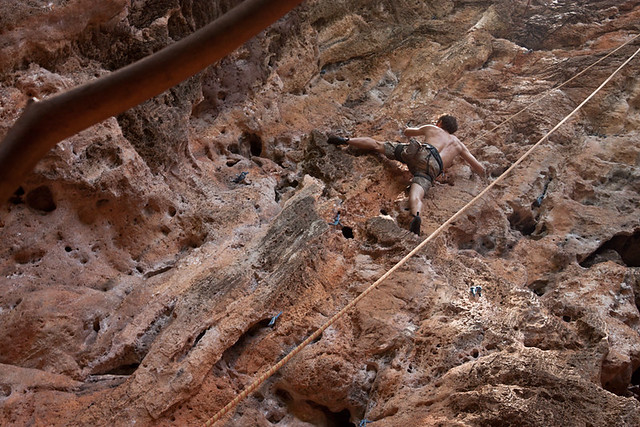
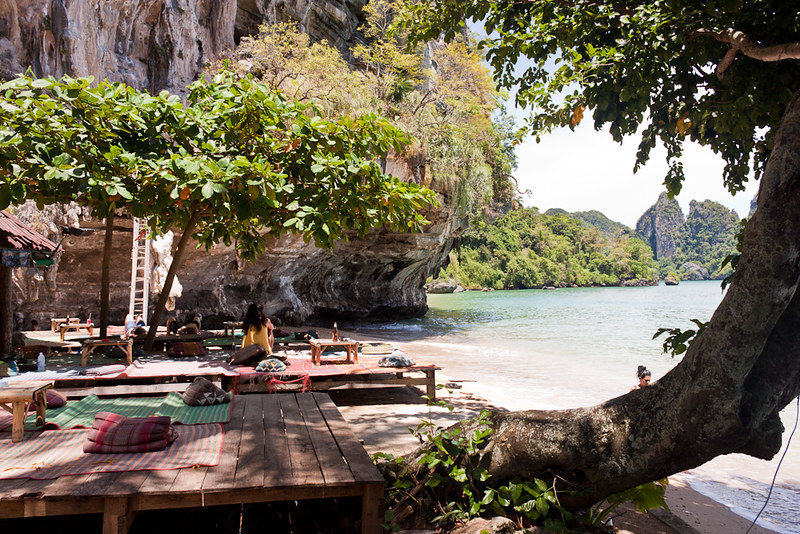 |
| Beach bums |

So we got ourselves booked in for a half day of climbing over on Railay. Without the burden of our gear we could skip over the intervening escarpment and get there without a boat, and Liv and I, with one of our amateur climbing friends from Tonsai, an Aussie by the name of Cyp, tottered around to the climbing routes on the east side with our harnesses and ropes. Our tutor was a local Thai who didn't talk too much, other than to show us the very basics of tying the appropriate knots, so we got very little feedback on our (lack of) technique, but she was patient enough, and gave us some pointers when we ran into trouble.

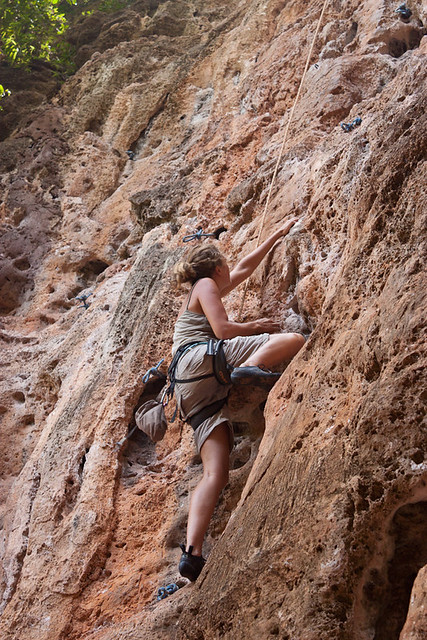 A half day course
may not sound like much, but climbing up rocks is absolutely
shattering, mentally as much as physically. Each time you tie
yourself in, chalk up your hands and take the first few steps up onto
the rock the task seems immense, weighty, and it gets your heart
going and sinks your stomach. Get yourself in an awkward position up
there too, with no decent footholds, and your energy is rapidly
drained as your fingertips pinch at folds in the stone, your arms
tense to try and take your weight, while the corner of one foot
miraculously grips what appears to be sheer rock, while the other
frantically searches for better purchase around a corner of the rock
that you can't see. Takes it out of you very quickly indeed.
A half day course
may not sound like much, but climbing up rocks is absolutely
shattering, mentally as much as physically. Each time you tie
yourself in, chalk up your hands and take the first few steps up onto
the rock the task seems immense, weighty, and it gets your heart
going and sinks your stomach. Get yourself in an awkward position up
there too, with no decent footholds, and your energy is rapidly
drained as your fingertips pinch at folds in the stone, your arms
tense to try and take your weight, while the corner of one foot
miraculously grips what appears to be sheer rock, while the other
frantically searches for better purchase around a corner of the rock
that you can't see. Takes it out of you very quickly indeed.
But we didn't do
too bad. We tried four routes, two 5c's, a 6a and a 6a+ - climbing
routes are graded by difficulty, with 5c being harder than a 5a, and
6a harder than a 5a etc. We managed the 5c's without any incident,
although 'easy' isn't a word I'd use to describe to them. The 6a had
an extremely tricky start comprising of an overhang that had to be
mounted by digging your feet into the corners of rock while dangling
from your arms, and monkeying upwards at a backwards leaning 45
degree angle. After all that, the vertical rock further up that route
came of something of a relief, and was conquered by all three of us.
The 6a+, I'm
afraid to say, was just too much for Liv and I. The first part was
tough, but manageable, but the last section swelled outwards and had
only sparsely dotted shallow holds, so we both hung there for
minutes, our fingers straining to hold up much of our bodyweight as
we balanced precariously feeling for the next hold up, which was
invariably another small dimple in the rock that just seemed too
meagre to use to haul our whole bodyweight up with. It was just
impossible, although Cyp managed it without too much fuss.
Rock climbing is
a tough old game, exhausting at the best of times and it can fray
your nerves when you're looping limbs around rocks tens of metres up,
hoping that that knot you tied earlier is going to hold you if you
slip. But it's a brilliantly simple challenge, tackling a rock. If
you don't manage it it's no big thing, you can always try again, and
you're not causing the rock any harm in having a go. And based on the
undulating shoulders and biceps of some of the more experienced
climbers, it seems like a pretty good way to get buff too.
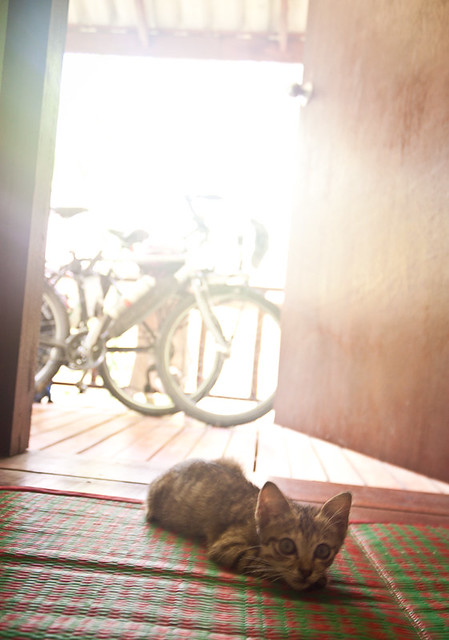 Perhaps the best
thing about rock climbing though is the culture that's attached to
it. A warm, thoughtful but playful bunch are climbers. By morning
patiently explaining basic technique to a newcomer to the wall, by
evening shrieking in a bobbing crowd in a jungle bar party.
Perhaps the best
thing about rock climbing though is the culture that's attached to
it. A warm, thoughtful but playful bunch are climbers. By morning
patiently explaining basic technique to a newcomer to the wall, by
evening shrieking in a bobbing crowd in a jungle bar party.
At around about
the five day mark we upgraded our accommodation to one of the jungle
bungalows, where the bathroom had tiles, the bedroom a wooden floor,
and there was no longer a constant dampness in the air. We even had a
free kitten thrown in. Or rather, one appeared on our porch and
through a system of bribery and attention it became a regular
companion of ours, dashing about the bedroom and scrabbling up the
mosquito net, or curled up on the chair outside at night, while Liv
and I read A Study in Scarlet.
A week turned into ten days, but by then we realised we really had to get going. Thailand is a long country, and we have a limited time to make it out the other side. It was a real shame because we had the chance to go climbing with a group of lovely people from Belgium and Germany, but there just wasn't any time and we had to draw a line under our little holiday and get going once more
A week turned into ten days, but by then we realised we really had to get going. Thailand is a long country, and we have a limited time to make it out the other side. It was a real shame because we had the chance to go climbing with a group of lovely people from Belgium and Germany, but there just wasn't any time and we had to draw a line under our little holiday and get going once more
One of the
climbers, Martin, helped us cart our bikes onto the boat, and joined
us on the trip around the bay to Ao Nang, a town closer to Tonsai
than Krabi (where we probably should have got the boat from in the
first place). We said farewell then pedalled back to Krabi town, and
our wooden hostel. Unfortunately another day off was required in
order to stock up on supplies and track down a bicycle shop to buy a
new front light, since mine had fallen off somewhere in Penang, and a
new speedometer, since the current one required endless adjusting
each morning to get it to register the wheel turning.
Finally, after
probably a little bit too long kicking back we set off from Krabi.
But I'm afraid those of you eager to hear about us thundering up the
length of Thailand will be disappointed, because we had another
weekend break to look forward to before we got going, courtesy of
Martyn Evans, a friend from university who had just moved to Nakhon
Si Thammarat, a provincial city on coast directly east of Krabi. It
was a two day push to get there, over flat, easy terrain.
It's all getting
a bit too easy isn't it, fair reader? Ten days off in Penang,
ten days off in Krabi, flat roads here there and everywhere. Even the
odd gang of yappy dogs giving chase can't ratchet up the
adventure-o-metre enough to counter all this wanton holidaying can
it?
Well, we decided
we were going to set ourselves as extra little challenge this month,
and try to buy as few plastic bottles and use as few plastic bags as
we possibly could. Probably the most important thing for us while we
cycle is water, so we didn't want to rule out bottled water all
together, so we're going to keep a tally of every bottle of water we
buy, and every plastic bag we use, and fine ourselves 25 baht
whenever we do. That's just under a dollar each time, and about three
times the price of the bottle of water.
Our goal would be
to do a whole month without getting a single fine, but if our
progress in May is anything to go by, we have a little way to go, but
it's really not impossible, it just requires a bit of forethought.
Most restaurants have large 20 litre bottles of filtered water that
we can use to top up our bottles and bladders, we just have to learn
the right Thai phrase to ask for it, and make sure we do top up
whenever we can. Most places that we've tried let us do this for
free, and those that ask for a donation only ask for a baht a litre,
which is extremely profitable for them, but also a very good price
for us so it's win win on both sides.
As for plastic
bags, we have plenty of them in our panniers, so all we need to do is
remember to bring them with us when we go shopping. Easier
said than done though, when you're in the habit of getting as many
bags as you want, free, whenever you go shopping.
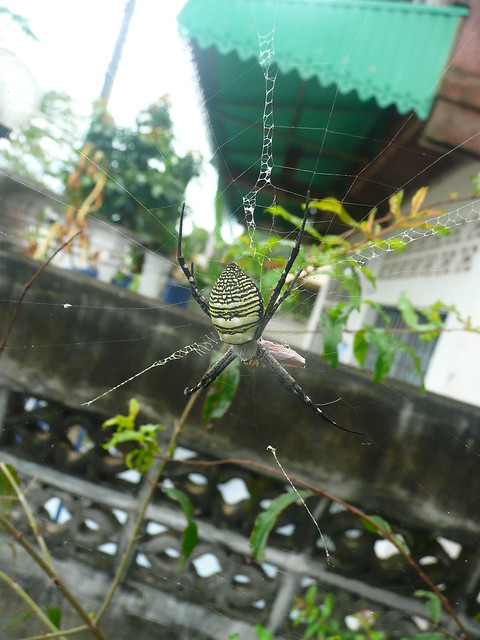 Plastic doesn't
disintegrate like organic waste, and hangs about for hundreds, and
sometimes thousands of years in the landfills, or wherever they wind
up. Plus they're made using petroleum or natural gas, two energy
sources that are liable to run out before too long, and while they
are still around their extraction invariably batters the environment.
Our attempted abstinence from it is not going to tidy up the Trang
coast, or make a difference to the landfills, or any of the rest of
it, but when you look into it it's fairly obviously that overusing
plastic bottles and plastic bags is no good thing, so we're going to
try not to do it.
Plastic doesn't
disintegrate like organic waste, and hangs about for hundreds, and
sometimes thousands of years in the landfills, or wherever they wind
up. Plus they're made using petroleum or natural gas, two energy
sources that are liable to run out before too long, and while they
are still around their extraction invariably batters the environment.
Our attempted abstinence from it is not going to tidy up the Trang
coast, or make a difference to the landfills, or any of the rest of
it, but when you look into it it's fairly obviously that overusing
plastic bottles and plastic bags is no good thing, so we're going to
try not to do it.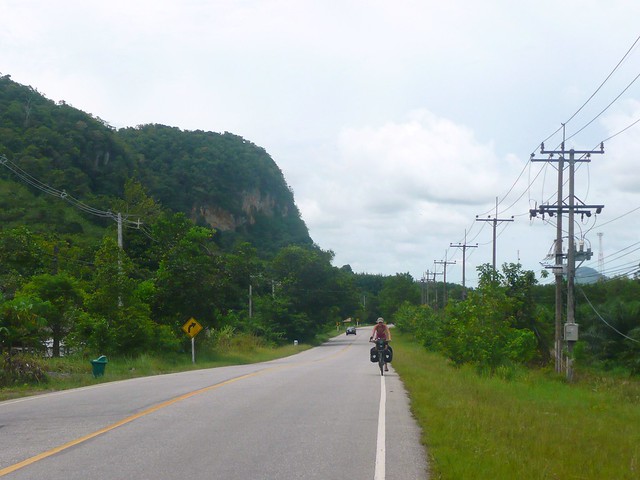 At the end of
each month we'll tally up how many bags we used, and bottles we
bought, and then pay our fine – 25 baht per bag or bottle – as a
donation to Solar Aid. So far May might be a bit costly for us, but
if it reduces the amount of bottles we buy, it will in the end save
us money on this trip, it'll be helping the environment, minuscule
though the impact will be, and while we're still committing
infringements Solar Aid will benefit with a few extra dollars each
month. It's a win-win situation really isn't it!
At the end of
each month we'll tally up how many bags we used, and bottles we
bought, and then pay our fine – 25 baht per bag or bottle – as a
donation to Solar Aid. So far May might be a bit costly for us, but
if it reduces the amount of bottles we buy, it will in the end save
us money on this trip, it'll be helping the environment, minuscule
though the impact will be, and while we're still committing
infringements Solar Aid will benefit with a few extra dollars each
month. It's a win-win situation really isn't it!Not for our wallets this month though. We lost track of a few plastic bags and bottles in the latter part of tosai, but based on the rest of our infractions we reckon we used about 25 bottles and 7 plastic bags, which leaves us with a £17 fine to pay. Eeesh. So far in June we've been a bit more canny with our plastic though, although yesterday we had to walk back from the shops with pockets bulging with packets of nuts and toiletries because we forgot to bring a bag!
A proper
normal weekend
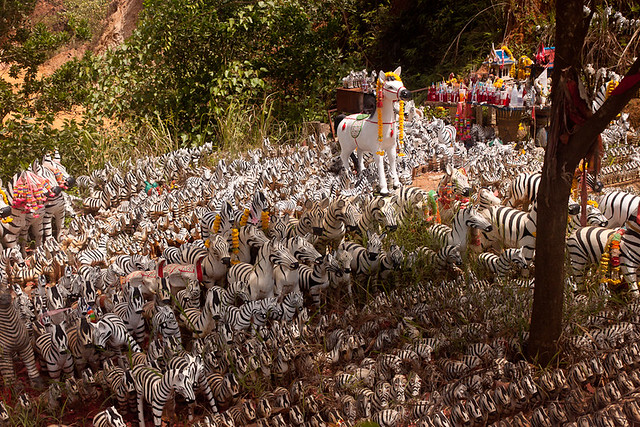 |
| We had such a good time at Martyn's that we forgot to take any photos, so here is a photo of lots of wooden zebras instead. |
Martyn, an old
friend from university, greeted us enthusiastically and led us
through the estate to his house where we were to spend the next few
nights. For the first time in about six months we were facing what
felt very much like a real weekend. By which I mean a weekend
populated by a rabble of western people, hanging out and doing
western things.
This might not
sound like much, and I don't think either of us expected it because
we hadn't really noticed the absence, but being suddenly propelled
into a home-away-from-home situation, was extraordinarily enjoyable.
Suddenly we weren't in Thailand, cycling, or even on a tropical
beach, thousands of miles from home, we were just round someone’s
house, having a party, and chatting to people about how their week
had been, and how work was, and all the rest of it.
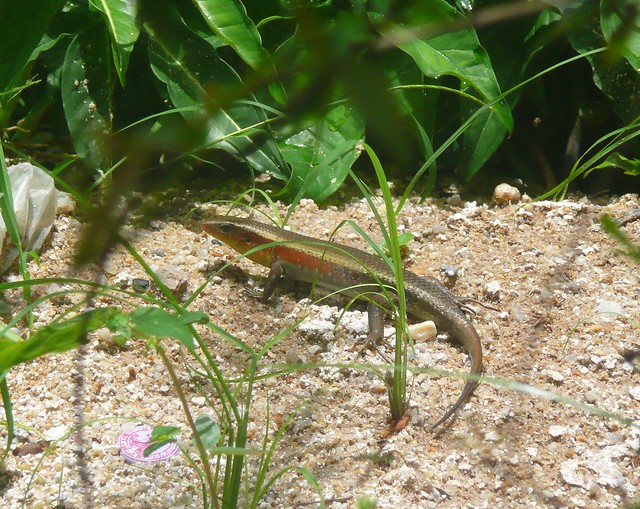 |
| And a lizard, |
This felt like a
normal weekend for the first time in a long time, and with Martin in
the role of gallant host it was just lovely. The Friday was spent at
a little house party down the way, Saturday spent flopped in front of
the TV watching QI, Michael Palin, and South Park, and then Sunday
lying in a hammock, chatting with Martyn and his friends about this
and that, before Liv went off to get a massage with the girls, and
Martyn and I stayed back to enjoy the pampering that slouching in a
hammock affords the senses.
They were a
lovely bunch, extremely welcoming and hospitable, and excellent
company. We were tempted, oh so very tempted to join them the next
weekend at the Full Moon Party in Ko Phagnan, but we realised when we
checked the calendar that we really, really had to get going
now. We have about 2000km to go to the northern border out of
Thailand into Laos, which is where we are shooting for, but less than
five weeks to get there. As with the run to Jakarta it's long, but
not impossible, but it means we're going to have to get our heads
down and get on with it. Cycling to China from Indonesia was never
going to be easy, but actually so far, we've managed to squeeze a
good amount of easy living between the slog. But with the shrinking
lengths of visas available to us, the next couple of months are going
to be a challenge. Should work off all the beers and barbecued
chicken anyway.
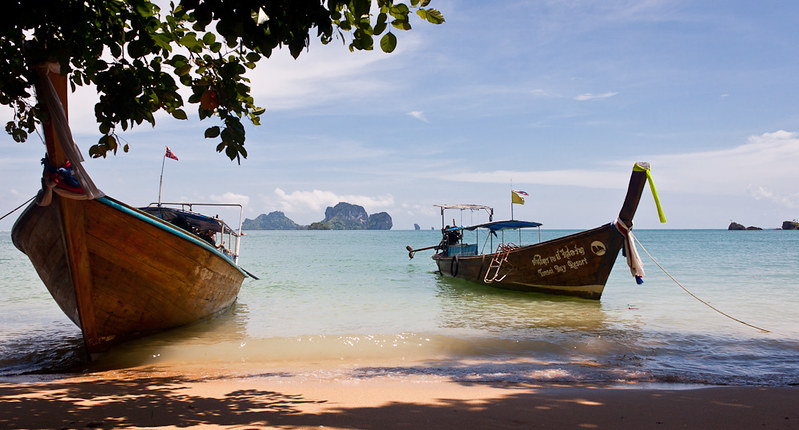 |

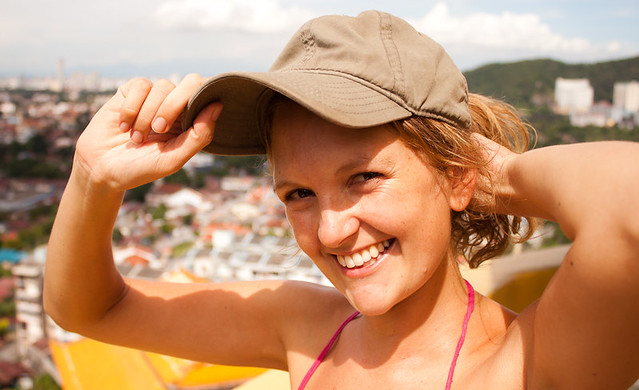
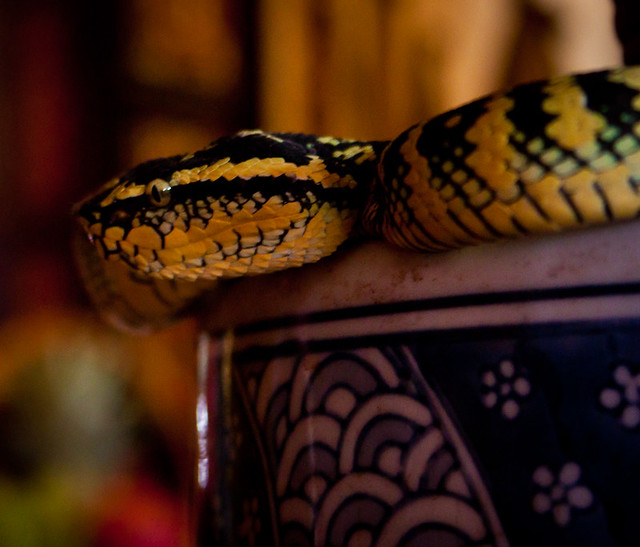



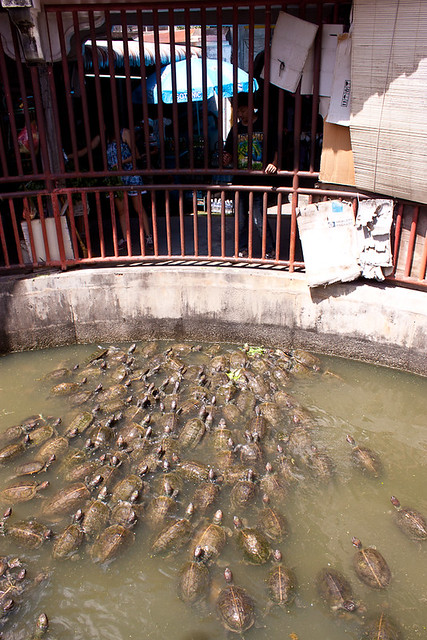




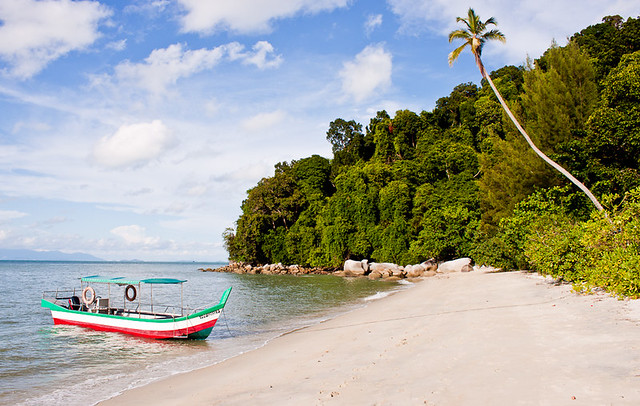

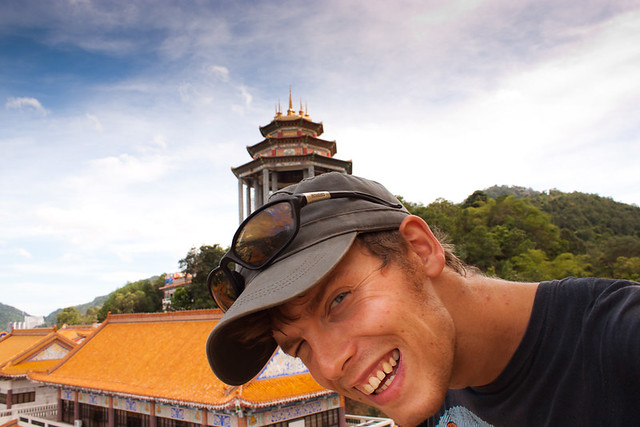
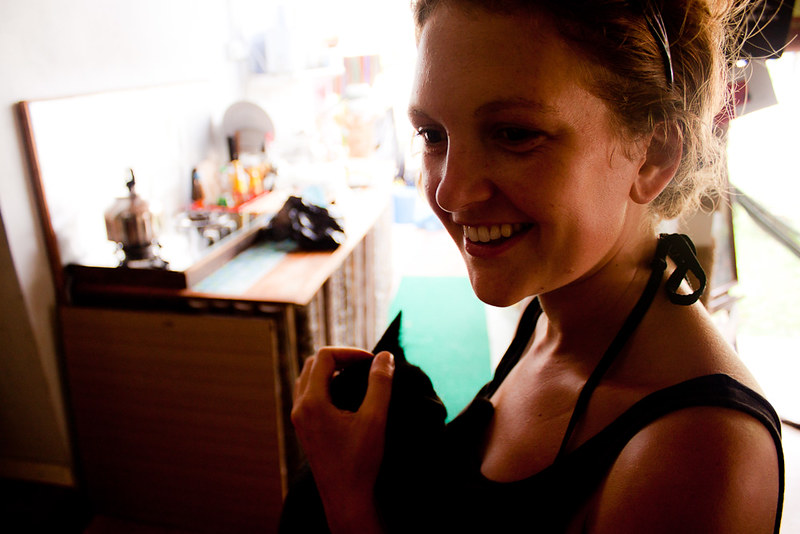

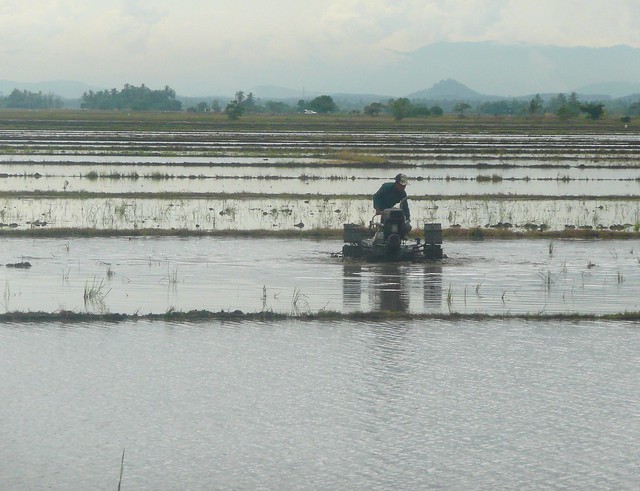
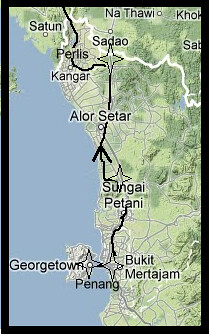

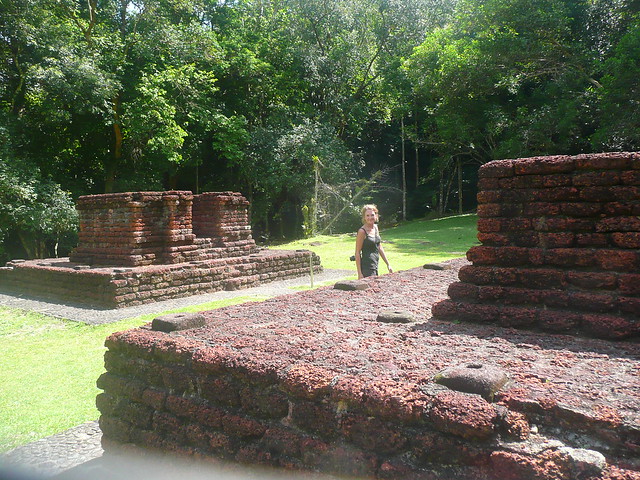
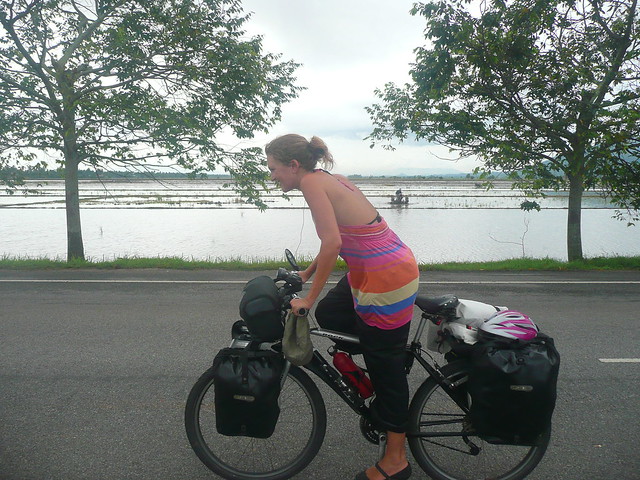

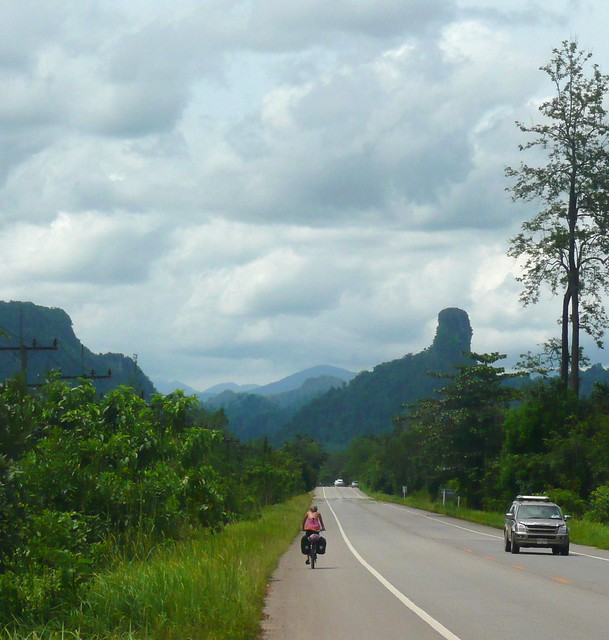

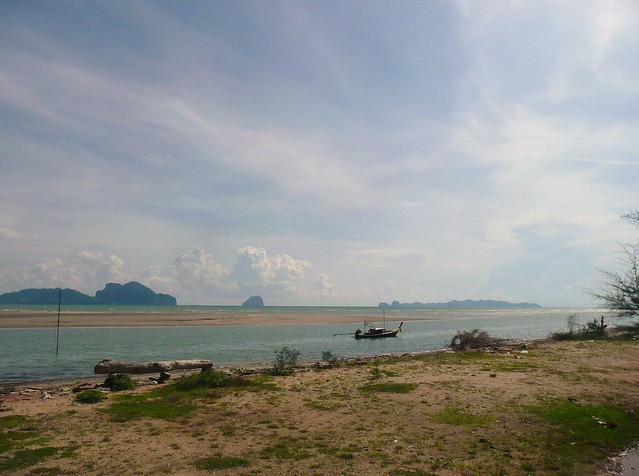
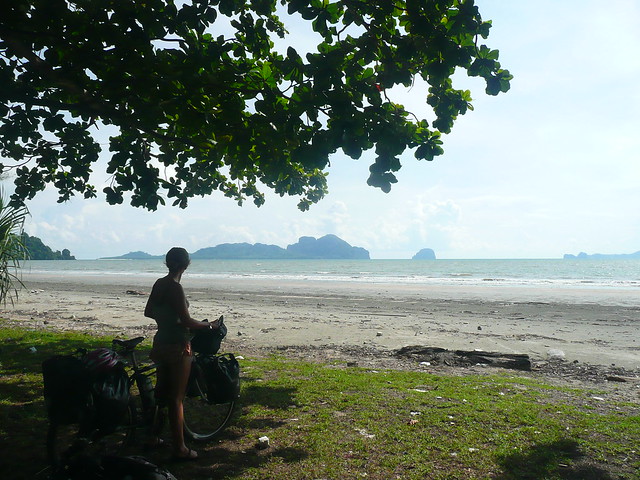
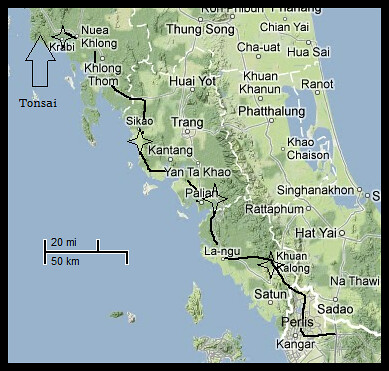
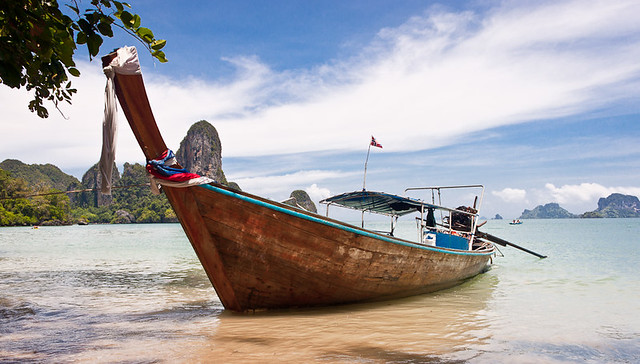
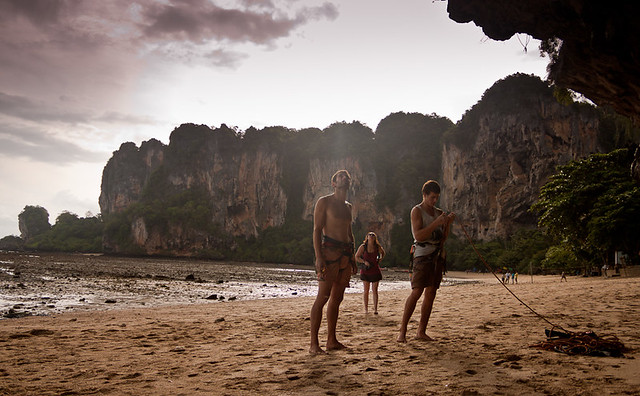
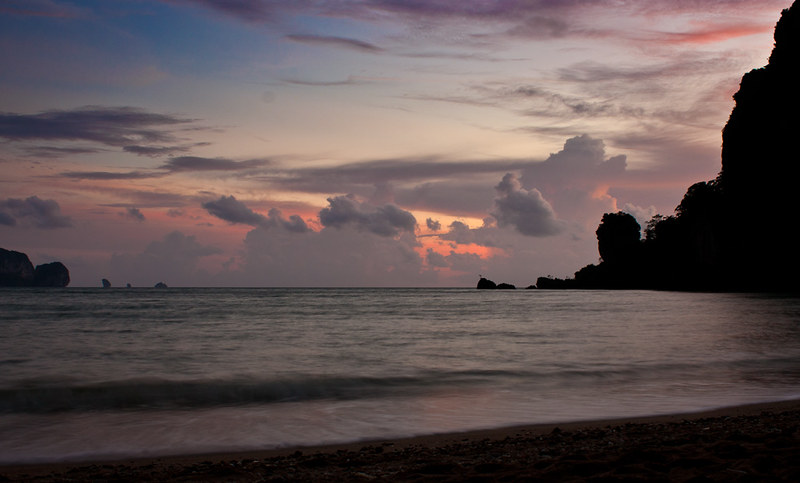
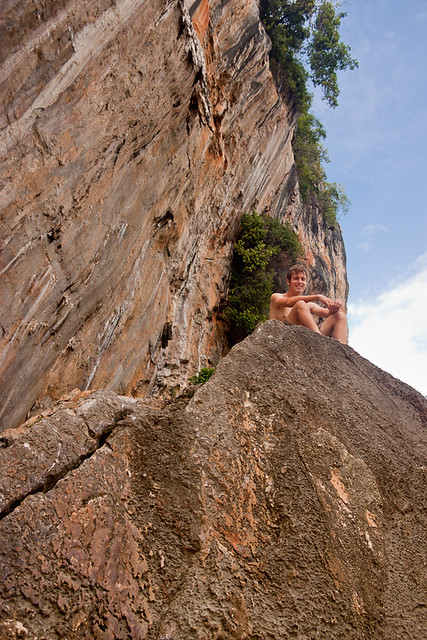
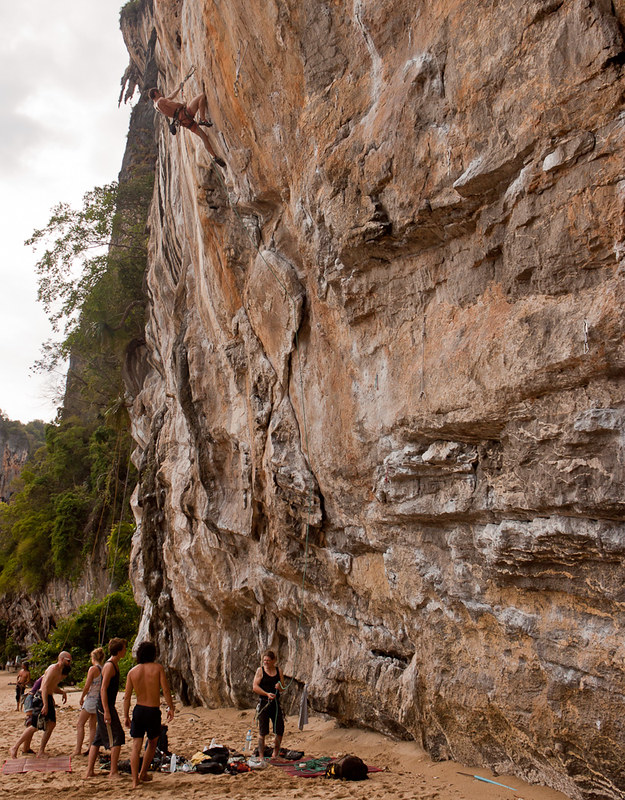

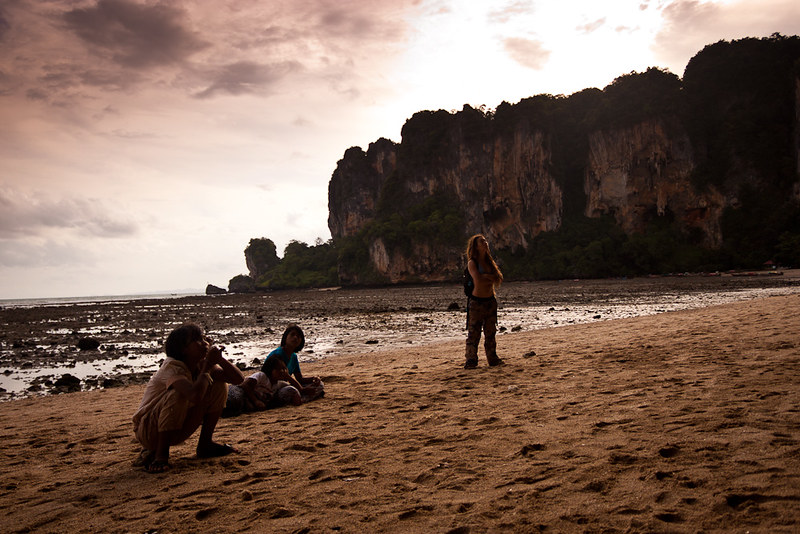
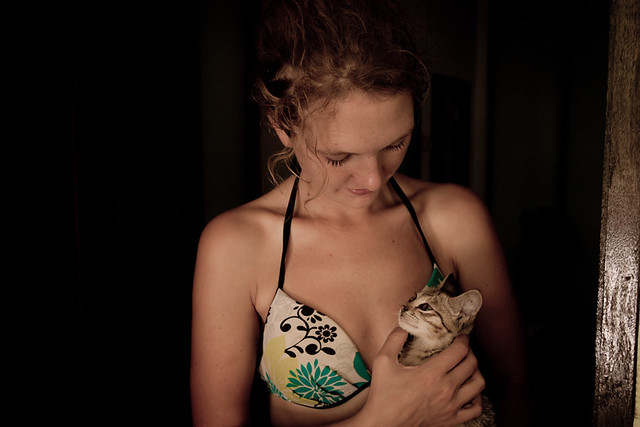

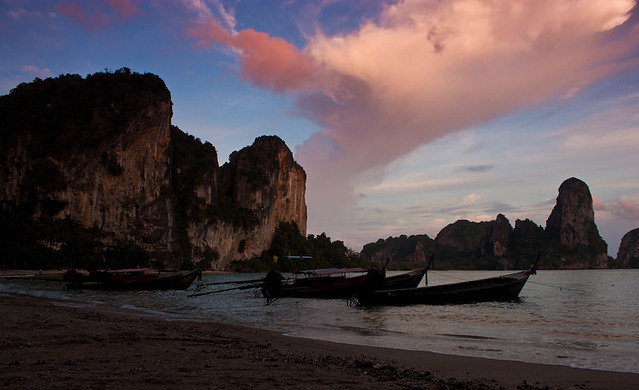


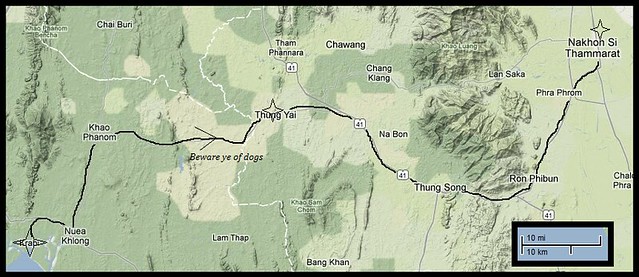

Liv and Robin, I am thoroughly enjoying reading your blog. I also know how much time has to go into writing something as detailed as this. Not a paragraph goes by that I'm not filled with envy - and that has to be an indication of your good writing. What a wonderful way to live your lives. Keep writing and maybe someday ye'll come visit and see if your bicycles can withstand the roads in Connemara. Love Debbie (Galway) x
ReplyDeleteHi! Thanks Debbie, glad you're enjoying it and what wonderful flattery from the finest blogger I know! Ireland is most certainly on our list of cycling adventures for the future good roads or not.
ReplyDeletex
A fantastic story. It's good to read about it all - the highs and the lows. It's very heart-warming to hear how nice, kind and generous everyone is (with the exception of the nasty boatman). It goes to show that most people in the world are good - must be wonderful to experience it. Love to you both C x
ReplyDelete